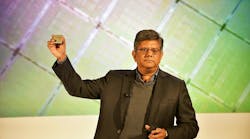Anand Chandrasekher, president of Qualcomm’s data center business unit, which has fought to show that the ARM architecture inside its smartphone chips can challenge Intel in corporate computing, has stepped away from Qualcomm, following reports that the company is trying to get out of the server space.
Qualcomm has been aggressively trying to build ARM-based processors to improve the energy efficiency of servers. The goal is to pry into Intel’s stranglehold over the server processor market, where the company holds more than 95 percent market share. But the server venture has been overshadowed in recent months by Qualcomm’s skirmishes with Apple and international regulators as well as Broadcom's hostile takeover attempt.
Chandrasekher’s exit follows a report from Bloomberg that Qualcomm is shopping its data center business. This year, as Qualcomm swatted at Broadcom’s hostile takeover, the company promised investors to check costs by cutting non-core business units. It’s the world’s largest maker of smartphone chips and makes massive profits from licensing wireless and other patents.
Qualcomm did not respond to a request to comment about Chandrasekher’s departure, which was first reported by news website Axios. Before taking over the server effort, Chandrasekher was Qualcomm's chief marketing officer, a position he filled after a decade holding marketing and management roles at Intel. He was promoted to president of Qualcomm data center technologies in late 2013.
His tenure culminated in the release of Qualcomm’s first server chip, the 48-core Centriq 2400. Last year, the company says that the chip offered better energy efficiency and cost than Intel’s Xeon Platinum 8180. It is manufactured with 10-nanometer technology, and is used in Microsoft’s Project Olympus platform. Qualcomm claims to have shipped over 1,000 samples to more than a dozen target customers.
Abandoning the server business would mean surrendering the data center chip market, which Qualcomm estimates will grow from $15 billion to $20 billion in the next two years. Typically, server chips sell for many thousands of dollars each and carry some of the highest development costs in the industry. One possibility for Chandrasekher is that he defects to one of Qualcomm's competitors in the space, like Marvell.
Last year, Marvell spent around $6 billion to acquire Cavium, which recently released its 64-bit, 54-core ThunderX2 processor. Another player is Ampere Computing, a startup headed by former Intel president Renee James. It's building chips based on the X-Gene ARM processor developed by Applied Micro, which Ampere bought from Macom Technology Solutions.
